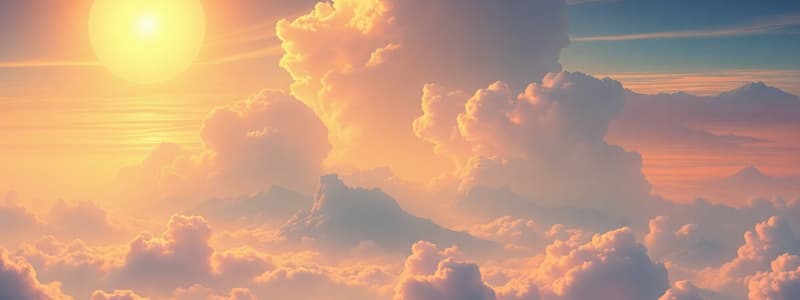Podcast
Questions and Answers
A scientist is studying the density of different atmospheric layers. In which layer would they find the highest density?
A scientist is studying the density of different atmospheric layers. In which layer would they find the highest density?
- Thermosphere
- Mesosphere
- Stratosphere
- Troposphere (correct)
If a new satellite is planned to orbit within the exosphere, what characteristic of this layer is most crucial for mission planning?
If a new satellite is planned to orbit within the exosphere, what characteristic of this layer is most crucial for mission planning?
- High concentration of ozone
- Extremely low gas density and potential particle loss to solar wind (correct)
- Abundant water vapor
- Presence of weather patterns
Nitrogen and oxygen constitute approximately what percentage of Earth's atmosphere?
Nitrogen and oxygen constitute approximately what percentage of Earth's atmosphere?
- 99% (correct)
- 21%
- 50%
- 78%
Commercial airplanes often fly in the lower stratosphere. Which of the following is the MOST likely reason for this?
Commercial airplanes often fly in the lower stratosphere. Which of the following is the MOST likely reason for this?
Meteors burn up as they enter Earth's atmosphere. Which atmospheric layer is primarily responsible for this?
Meteors burn up as they enter Earth's atmosphere. Which atmospheric layer is primarily responsible for this?
The International Space Station orbits Earth within a specific atmospheric layer to minimize drag while remaining close enough for operations. Which layer is this?
The International Space Station orbits Earth within a specific atmospheric layer to minimize drag while remaining close enough for operations. Which layer is this?
Water vapor content varies significantly within which layer of the Earth's atmosphere?
Water vapor content varies significantly within which layer of the Earth's atmosphere?
Which of the following best describes the role of gravity in relation to Earth's atmosphere?
Which of the following best describes the role of gravity in relation to Earth's atmosphere?
Which of the following gases, despite its relatively low concentration, plays a crucial role in absorbing harmful ultraviolet light in the stratosphere?
Which of the following gases, despite its relatively low concentration, plays a crucial role in absorbing harmful ultraviolet light in the stratosphere?
If the concentration of atmospheric methane ($CH_4$) were to double, what primary effect would this have on Earth's climate?
If the concentration of atmospheric methane ($CH_4$) were to double, what primary effect would this have on Earth's climate?
What is the primary reason the Montreal Protocol was created and considered successful?
What is the primary reason the Montreal Protocol was created and considered successful?
Which of the following best describes the role of greenhouse gases in regulating Earth's temperature?
Which of the following best describes the role of greenhouse gases in regulating Earth's temperature?
How would Earth's climate be different in the absence of the greenhouse effect?
How would Earth's climate be different in the absence of the greenhouse effect?
Considering the composition of Earth's atmosphere, which of the following human activities contributes most significantly to the increase in global carbon dioxide levels?
Considering the composition of Earth's atmosphere, which of the following human activities contributes most significantly to the increase in global carbon dioxide levels?
If a new chemical is developed that significantly reduces the concentration of water vapor in the atmosphere, what is the most likely impact on Earth's climate, assuming all other factors remain constant?
If a new chemical is developed that significantly reduces the concentration of water vapor in the atmosphere, what is the most likely impact on Earth's climate, assuming all other factors remain constant?
Flashcards
Atmosphere
Atmosphere
A thin layer of gases surrounding a planet, held in place by gravity.
Main Gases in Earth's Atmosphere
Main Gases in Earth's Atmosphere
Nitrogen gas (N2) and Oxygen gas (O2).
Troposphere
Troposphere
The lowest layer of Earth's atmosphere, where weather occurs and life exists.
Stratosphere
Stratosphere
Signup and view all the flashcards
Mesosphere
Mesosphere
Signup and view all the flashcards
Thermosphere
Thermosphere
Signup and view all the flashcards
Exosphere
Exosphere
Signup and view all the flashcards
Atmospheric Gas Percentages
Atmospheric Gas Percentages
Signup and view all the flashcards
What percentage of the atmosphere is Nitrogen (N2)?
What percentage of the atmosphere is Nitrogen (N2)?
Signup and view all the flashcards
What is Ozone (O3)?
What is Ozone (O3)?
Signup and view all the flashcards
What is the function of the ozone layer?
What is the function of the ozone layer?
Signup and view all the flashcards
What are greenhouse gases?
What are greenhouse gases?
Signup and view all the flashcards
Name the most important greenhouse gases.
Name the most important greenhouse gases.
Signup and view all the flashcards
What is global warming (climate change)?
What is global warming (climate change)?
Signup and view all the flashcards
What would happen without the greenhouse effect?
What would happen without the greenhouse effect?
Signup and view all the flashcards
Study Notes
- The atmosphere is a layer of gases around a planet, held by gravity.
- Earth's atmosphere primarily consists of nitrogen, oxygen, and argon.
- The atmosphere extends approximately 300 miles from the Earth's surface.
Atmospheric Layers
- The atmosphere is divided into five layers: troposphere, stratosphere, mesosphere, thermosphere, and exosphere.
- Troposphere:
- The lowest layer, from the surface to 7.5 miles.
- It is the home to humans, animals, and plants.
- It is the densest layer.
- It is where weather occurs and contains 99% of the atmosphere's water vapor.
- Stratosphere:
- Located above the troposphere, extending from 7.5 to 31 miles.
- Contains the ozone layer.
- Commercial jets fly here to avoid weather turbulence.
- Mesosphere:
- Extends from 31 to 50 miles.
- It is a cold layer where meteors burn up.
- Can be reached by small rockets and rocket-powered aircraft.
- Thermosphere:
- Ranges from 50 to 440 miles.
- Features very low density, and is free of clouds and water vapor.
- The International Space Station orbits within this layer.
- Exosphere:
- Extends from 440 to 6,200 miles.
- The atmosphere merges with outer space.
- Particles are of very low density and often lost to space due to solar wind.
- Most of Earth's satellites orbit here.
- The atmosphere is generally defined as the first 62 miles (100 kilometers) of gases.
Atmospheric Gas Composition
- Nitrogen (N2) accounts for approximately 78.08%.
- Oxygen (O2) accounts for approximately 20.95%.
- Water (H2O) accounts for approximately 0.4%.
- Argon (Ar) accounts for approximately 0.93%.
- Carbon Dioxide (CO2) accounts for approximately 0.04%.
- Neon (Ne) accounts for approximately 0.002%.
- Helium (He) accounts for approximately 0.0005%.
- Methane (CH4) accounts for approximately 0.0002%.
- Hydrogen (H2) accounts for approximately 0.00005%.
- Nitrous Oxide (N2O) accounts for approximately 0.00003%.
- Ozone (O3) accounts for approximately 0.000004%.
Importance of Gases
- The atmosphere supports life through respiration and photosynthesis.
- Most important benefits are the ozone layer and the greenhouse effect.
The Ozone Layer
- Located in the stratosphere.
- Ozone consists of three oxygen atoms (O3)
- It absorbs ultraviolet light
- It prevents most UV light from reaching Earth's surface, protecting life from its harmful effects.
- Damage to the ozone layer was caused by chemicals like chlorofluorocarbons (CFCs).
- The Montreal Protocol in 1987 banned these chemicals.
- The ozone layer has been recovering since these bans.
The Greenhouse Effect
- Without the greenhouse effect, Earth would be about 59°F colder.
- Greenhouse gases trap infrared light, warming the Earth.
- Key greenhouse gases include carbon dioxide, methane, and water vapor.
- Human activities have increased carbon dioxide levels through burning fossil fuels.
- This has led to global warming (climate change), causing an artificial increase in Earth's average temperature.
Studying That Suits You
Use AI to generate personalized quizzes and flashcards to suit your learning preferences.




